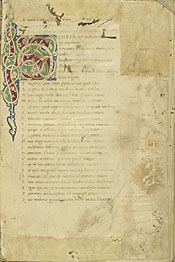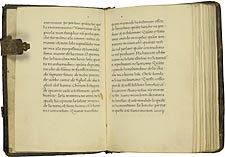Eaten by Worms
![]()
Wormholes are visible in these two examples, indicating that insects have
feasted upon them. The copy of Juvenal is so badly worm-eaten that some
of its text has been lost, and a strip of parchment has been added to
mend the page.
The vernacular book, which offers meditations on the Passion of Christ,
has fared better. Although two small wormholes near the top have left
the text unimpaired, the book has apparently preserved the crushed remains
of an insect, visible in the inner margin of the left page. The term "bookworm"
generally refers to the larvae of a certain family of beetles (Bostrichidae),
but these are not the only insects that destroy books; other offenders
include moth larvae, silverfish, cockroaches, and booklice.
![]()
[top] Juvenal. Satires. Italy, last quarter of
the fifteenth century. [bottom] Meditatione de la Passione.
Italy, fifteenth century.
![]()

Copyright
© 2002 Division of Rare & Manuscript
Collections
2B Carl A. Kroch Library, Cornell University, Ithaca, NY, 14853
Phone Number: (607) 255-3530. Fax Number: (607) 255-9524
For
reference questions, send mail to:
rareref@cornell.edu
If you have questions or comments about the site, send mail to: webmaster.

